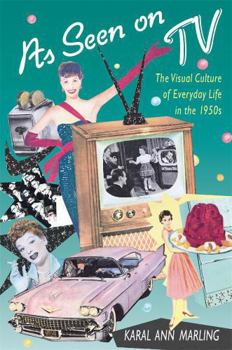As Seen on TV: The Visual Culture of Everyday Life in the 1950s
Select Format
Select Condition 
Book Overview
America in the 1950s: the world was not so much a stage as a setpiece for TV, the new national phenomenon. It was a time when how things looked--and how we looked--mattered, a decade of design that comes to vibrant life in As Seen on TV . From the painting-by-numbers fad to the public fascination with the First Lady's apparel to the television sensation of Elvis Presley to the sculptural refinement of the automobile, Marling explores what Americans...
Format:Paperback
Language:English
ISBN:0674048830
ISBN13:9780674048836
Release Date:March 1996
Publisher:Harvard University Press
Length:336 Pages
Weight:1.12 lbs.
Dimensions:1.0" x 6.1" x 9.2"
Customer Reviews
4 ratings
Very interesting read
Published by Thriftbooks.com User , 15 years ago
I was born in the 60s but have always had an interest in the 50s. This book gave me some feel for it. Everything from food to Elvis getting his hair cut, to those big wings on cars is here. Even the paint-by-numbers craze is written up. There is a chapter on Disneyland 1955 too. The "New Look" is here, that fashion style after the war. There arent tons of pics, and what there are are black and white.
Terrific Pop Culture Book
Published by Thriftbooks.com User , 15 years ago
A breezy and yet analytical look at the 1950's. The usual suspects are on display here: TV, Disney, sex, hairstyles, fashion, hokey futurism, sex, the rise of suburbia, Nixon and the Eisenhowers, cars with big fins, sex, and cold war anxiety. But what sets this book apart is the Marling is a real writer. Combining a warm love of Americana with an anthropolgist's eye for detail, she makes vital comments on post-war American culture. Excelsior!
"Life In The Age Of Television Was A Feast For The Eye..."
Published by Thriftbooks.com User , 24 years ago
Karal Ann Martling tucks her mission in writing "As Seen On TV" in that last sentence of the next-to-last chapter of her fascinating book. She tours the 1950s' TV-raised images, from First Lady Mamie Eisenhower's dress closet to her husband's paintings to garish car in the garage, ready-made food in the kitchen, and herky-jerky TV images pointing to changed American culture and aestetic. Hers is a more entertaining, breezier read than recent books from, respectively, David Halberstam on the 1950s or historian Michael Kammen on American preference.(Marling shared time at Cornell with Kammen, thanking his students in her acknowledgements for "challenging lunchtime conversation.")Marling merges era icons, fads, and seminal events more seamlessly into social statement than Halberstam did or Kammen attempted. Her understanding of cars evolving into social statements segues best into the image of Elvis Presley, the "King of Rock and Roll" for whom the "gorp"-covered Cadillac was chariot of choice. (she also credits Martin and Lewis with exposing the entertainment's dual sensibilities during early TV).Marling also writes of home convenience from new appliances and quick dinners colliding with the rustic, more honorable life many felt had been replaced. This clash inspired and popularized Grandma Moses' idealized portraits of American country life, Walt Disney's scale model re-creation of small-town America at Disneyland (and on the accompanying TV program), and Betty Crocker's shorthand version of motherly mentoring through General Mills' best-selling cookbook. Marling's chapter on Walt Disney's inspirations for creating the park is among the book's most fascinating. But a chapter on "American Bandstand," should Marling have chosen to include it, may have tied even more loose ends together.The book may also have done with some re-arrangement; the closing chapter accurately and humorously chronicles the 1959 Richard Nixon-Nikita Krushchev "kitchen debate." But its tale of form of function, argued by its most important leaders at the peak of Cold War hysteria, may have been more effective introducing Marling's tale. The book may then have received more social context by stating sooner Nixon's belief, according to Marling, in "style as a manifestation or a symbol of difference and, in difference, multiplicity - the possibility of choice - as...connecting idle consumer fetishism to ideology." This would also have more closely tied the 1950s' garish color imagery with its parallel, grainier black-and-white images (Nixon, the Cold War, and Joe McCarthy, a standout 50s figure seen on TV but not in this book.) Nonetheless, "As Seen On TV" is a fun, informative read for those wishing to understand the reasoning behind an era's unforgettable images.
Very interesting book with wonderful photographs
Published by Thriftbooks.com User , 25 years ago
Very interesting reading. It is amazing to actually see how television has changed American life. I can't even fathom how life would be today, without TV. A great read for all who are interested in American pop culture in the 1950s.






